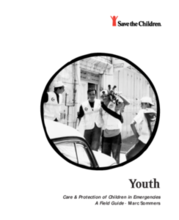In today's humanitarian crises, civilians face ever more attacks and targeting by perpetrators of violence. And amongst these civilians — largely women and children — youth seem to have been forgotten in humanitarian priorities. Caught somewhere between their young childhood and full adulthood, youth struggle with their own identity as they watch the social fabric collapse around them: homes are destroyed, communities are divided by violence, and their own hopes for a better future are crushed.
Years of experience have shown that youth tend to fall between the cracks during emergencies: while refugee children may be underserved in many crises, adolescents and youth are often forgotten completely. ’Youth‘ covers both adolescents (with rights under the CRC) as well as young adults, crossing convenient categories and too easily ignored. These young people — who are no longer children requiring full protection from their families, and yet are not recognized as adults with full social responsibility — are an important part of any refugee population and key to social rehabilitation. Communities may see young people as a threat to their own security, while humanitarian agencies too easily dismiss adolescents and young adults as too difficult to approach. Save the Children is committed to ensuring that youth do indeed have a voice in their own future, and providing them with the skills they need to realize their own hopes and dreams.
After consultations with staff at both headquarters and in the field, it became clear that there was a need not only for a thematic overview on key youth protection concerns, but also a quick and practical reference for practitioners when facing new emergencies or designing new programs. With this in mind, the Children in Crisis Unit has designed this series of field guides as the basis for in-depth training sessions on priority subjects, while including quick implementation tools such as checklists of key concerns and rapid guideline references in a portable format.
The field guides have been designed specifically for SC field, headquarters, and partner organization staff members who are involved in the design and management of children and war programs. As such, the series builds on Save the Children's specific approach and programming principles while also bringing in best practices and examples from other agencies’ experience. At the same time, however, we hope that these field guides may also prove useful to other organizations engaged in similar programming and contribute to the further development of child-focused emergency programs within the international community.
Youth programming in emergencies has been largely ignored, and this field guide is an important step towards both raising awareness of youths’ specific concerns as well as supporting Save the Children’s staff in their work with this population. In crisis situations, immediate protection for youth is as important as working with them to plan their own future. Growing into adulthood can be difficult in any setting, but in a refugee camp the challenges can seem overwhelming.
©Save the Children

